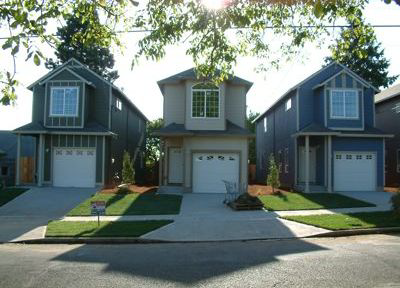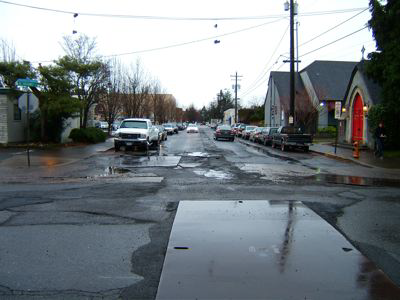No Light Rail in Vancouver!
The Problems with Infill

For many years, Salem — Oregon’s capital — was a sleepy, slow-

Oregon’s capitol building in the state capital of Salem; photo from salemoregon.com.
When Portland housing prices started climbing in the early 1990s, Salem — located just 45 miles away — was one of the relief valves for people needing affordable housing, the other being Vancouver, Washington. Vancouver remains affordable, but now Salem is rapidly losing its affordability.
Between 1990 and 2000, Salem overtook Eugene as the state’s second-
Salem’s response is infill development, which in this case means that the city is
freely allowing property owners and developers to subdivide lots in single-
Of course, partitions are bound to make neighbors upset. I don’t really have any
sympathy for someone who wants to stop home construction on a vacant lot because
they are used to using the lot as their own private park. But I can understand how
people living in a neighborhood of nice homes on quarter-

Portland encourages developers to partition quarter-
But even beyond this, the whole question of infill development is based on a series of myths that are demonstrably false.
- Myth: We can’t expand the urban-
growth boundary because we are running out of farmland. Reality: A study commissioned by an Oregon smart-growth group found that eliminating growth boundaries and all other planning rules would lead to the development of only 1 percent more land in Oregon’s Willamette Valley in the next 50 years. - Myth: The costs of sprawl are so great that infill is cheaper.Reality: The Costs
of Sprawl 2000 found (using someone questionable techniques) that sprawl added $11,000
to the cost of a new suburban home. Meanwhile, my research has shown that Oregon’s
land-
use planning has added at least $60,000 to the cost of a Portland home and $23,000 to the cost of a Salem home (and that is every home, not just the new ones). - Myth: Sprawl imposes higher urban-
service costs on cities. - Reality: At some point, when you increase densities, you have to completely replace the water, sewer, and other infrastructure to serve those higher densities, as is happening in the Portland neighborhood shown below. This costs far more than extending services for greenfield development on the urban fringe.

When Oregon first began land-
Of course, all urban areas in Oregon only cover 1.25 percent of the state. Without
land-
But drawing the boundaries gave people a sense of entitlement. In the late 1980s,
1000 Friends of Oregon joined with some city leaders (who wanted growth to take place
in their cities instead of in some suburb or unincorporated area) to form a “zero-
Unaffordable housing plays into the hands of planners who think we should live in
more compact cities. In 2005, Portland planners were elated to announce that the
city’s urban-
That is not something to be happy about. It is something to be ashamed of. Infill can play a role in urban growth, but when it is motivated by artificially high land prices, it is more likely to be destructive than constructive.
11
Trackback • Posted in News commentary, Regional planning
Reprinted from The Antiplanner